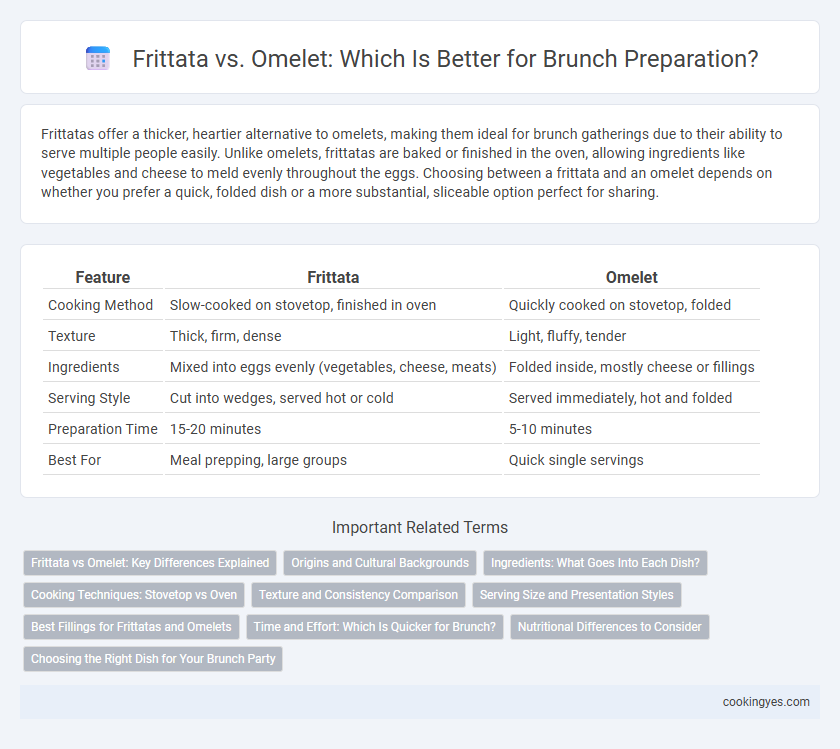Frittatas offer a thicker, heartier alternative to omelets, making them ideal for brunch gatherings due to their ability to serve multiple people easily. Unlike omelets, frittatas are baked or finished in the oven, allowing ingredients like vegetables and cheese to meld evenly throughout the eggs. Choosing between a frittata and an omelet depends on whether you prefer a quick, folded dish or a more substantial, sliceable option perfect for sharing.
Table of Comparison
| Feature | Frittata | Omelet |
|---|---|---|
| Cooking Method | Slow-cooked on stovetop, finished in oven | Quickly cooked on stovetop, folded |
| Texture | Thick, firm, dense | Light, fluffy, tender |
| Ingredients | Mixed into eggs evenly (vegetables, cheese, meats) | Folded inside, mostly cheese or fillings |
| Serving Style | Cut into wedges, served hot or cold | Served immediately, hot and folded |
| Preparation Time | 15-20 minutes | 5-10 minutes |
| Best For | Meal prepping, large groups | Quick single servings |
Frittata vs Omelet: Key Differences Explained
A frittata differs from an omelet primarily in cooking technique and texture, as it is started on the stovetop and finished in the oven, resulting in a thicker, more custard-like consistency ideal for brunch servings. Omelets are typically cooked quickly on the stovetop, folded, and have a lighter, fluffier texture, making them perfect for quick, single-portion meals. The frittata's ability to incorporate a wider variety of ingredients mixed directly into the eggs offers versatility and ease of preparation when hosting larger brunch gatherings.
Origins and Cultural Backgrounds
Frittata, originating from Italy, is a versatile egg dish traditionally mixed with various ingredients before cooking, reflecting the country's rustic culinary heritage. In contrast, the omelet, with roots tracing back to ancient Persia and popularized in French cuisine, features beaten eggs cooked quickly and folded around fillings, symbolizing elegance and simplicity. Understanding these distinct origins highlights their cultural significance and influences in modern brunch preparations worldwide.
Ingredients: What Goes Into Each Dish?
Frittatas typically incorporate a mix of beaten eggs combined with various ingredients like vegetables, cheese, meats, and herbs directly folded in before cooking, creating a thick, hearty dish ideal for brunch. Omelets use eggs beaten separately and cooked into a thin layer before fillings such as cheese, vegetables, and meats are added and folded inside, offering a lighter and more delicate texture. The key difference lies in how ingredients are integrated, with frittatas being more ingredient-heavy and omelets emphasizing a balance between eggs and fillings.
Cooking Techniques: Stovetop vs Oven
Frittatas are typically cooked using a combination of stovetop and oven techniques, starting with sauteing ingredients in a skillet before finishing under the broiler to achieve a firm, evenly cooked texture. Omelets are primarily prepared entirely on the stovetop, where eggs are quickly cooked and folded around fillings for a soft, tender consistency. Utilizing the oven for frittatas allows for serving larger portions and a hands-off cooking process, while stovetop omelets require constant attention and skillful folding for perfect presentation.
Texture and Consistency Comparison
Frittatas have a denser, creamier texture due to slow cooking and baking, resulting in a firm yet tender consistency that holds fillings evenly throughout. Omelets offer a lighter, fluffier texture, achieved by quickly cooking beaten eggs, which creates a soft, delicate interior with a slightly crisp outer layer. Both provide distinct mouthfeels ideal for brunch, with frittatas suited for a hearty, sliceable option and omelets preferred for a quick, foldable serving.
Serving Size and Presentation Styles
Frittatas offer larger serving sizes ideal for group brunches, as they are baked in a single pan and sliced into portions, ensuring even distribution of ingredients. Omelets typically serve one person and are folded individually, allowing for personalized fillings and elegant presentation on separate plates. While frittatas emphasize communal sharing with a rustic appearance, omelets provide a refined, customizable option suited for individualized presentation styles.
Best Fillings for Frittatas and Omelets
Frittatas suit hearty fillings like roasted vegetables, cheese, potatoes, and meats due to their open-faced, baked style that melds flavors evenly. Omelets work best with lighter, quick-cooking ingredients such as fresh herbs, mushrooms, tomatoes, spinach, and soft cheeses, which fold smoothly within the delicate egg layer. Both breakfast staples offer versatile bases, but optimal fillings depend on preparation method and desired texture for brunch menus.
Time and Effort: Which Is Quicker for Brunch?
Omelets typically require less time and effort for brunch preparation, as they cook quickly on the stovetop and involve simple folding techniques. Frittatas, by contrast, need longer cooking time due to baking or slow stovetop cooking to set the eggs evenly. Choosing an omelet can streamline brunch preparation with faster results, while frittatas demand more patience but yield a heartier dish.
Nutritional Differences to Consider
Frittatas generally contain more eggs and additional ingredients like vegetables, cheese, and meats, resulting in higher protein, fat, and calorie content compared to traditional omelets. Omelets typically have fewer fillings, making them lower in calories and fat, which can be beneficial for lighter brunch options. Considering nutritional needs, frittatas offer a denser source of energy and nutrients, while omelets provide a leaner, customizable meal choice.
Choosing the Right Dish for Your Brunch Party
Frittatas offer a versatile and hearty option for brunch parties, as they can be prepared in advance and served at room temperature, making them ideal for serving multiple guests. Omelets provide a quick, customizable dish that cooks rapidly and is best enjoyed fresh, perfect for individualized portions. Selecting between a frittata and an omelet depends on the desired serving style, preparation time, and guest preferences for a seamless brunch experience.
Frittata vs Omelet for brunch preparation Infographic

 cookingyes.com
cookingyes.com